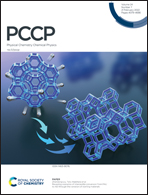Valley splitting and magnetic anisotropy in two-dimensional VI3/MSe2 (M = W, Mo) heterostructures
Abstract
As a new van der Waals ferromagnetic material, VI3 can be used to lift the valley degeneracy of transition metal dichalcogenides at the K′ and K points. Here, the electronic structure and magnetic anisotropy of the VI3/MSe2 (M = W, Mo) heterostructures are studied. The VI3/WSe2 heterostructure is semiconducting with a band gap of 0.26 eV, while the VI3/MoSe2 heterostructure is metallic. Considering the spin–orbit-coupling, a maximum valley splitting of 3.1 meV appears in the VI3/WSe2 heterostructure. The biaxial strain can tune the valley splitting and magnetic anisotropy of VI3/MSe2 heterostructures. In the VI3/WSe2 heterostructure, which has the most stable stacking, valley splitting can be increased from 1.8 meV at 4% compressive strain to 3.1 meV at 4% tensile strain. At a biaxial strain of −2% to 4%, the VI3/WSe2 heterostructure maintains a small perpendicular magnetic anisotropy, while the VI3/MoSe2 heterostructure shows in-plane magnetic anisotropy under different strains. The significantly tunable electronic structure and magnetic anisotropy under biaxial strain suggest that the VI3/MSe2 heterostructures have potential applications in spintronic devices.



 Please wait while we load your content...
Please wait while we load your content...